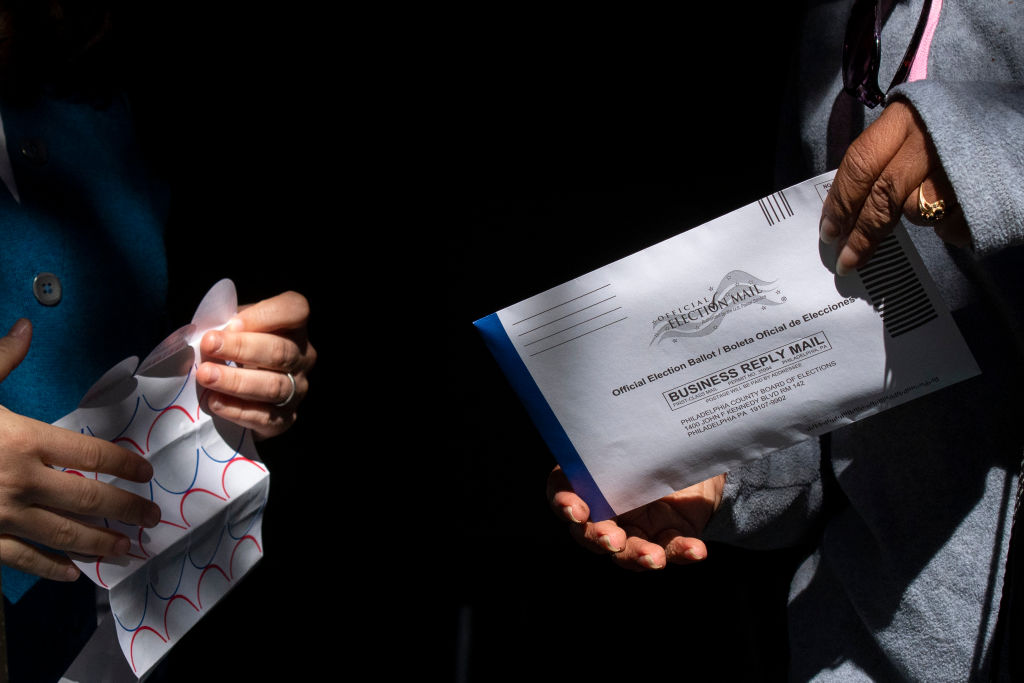A voter casts her early voting ballot on October 17, 2020 in Philadelphia. (Photo by Mark Makela/Getty Images)
In a shocking and frankly disappointing turn of events, the Pennsylvania Supreme Court on Saturday decided it won’t hear two highly consequential cases dealing with the commonwealth’s mail-in ballots.
In other words, they whiffed. And Pennsylvanians must now go into Election Day with no more clarity than they had at this time in 2020.
The court dismissed a request by a group of voting-rights organizations to block a rule that requires mail-in ballots to have the hand-written date on the return envelope. That we are still litigating those envelopes four years later is unbelievable, but the court majority is concerned making a change in the voting rules too close to the election was too risky.
So the court is suggesting that making a change in the voting rules after the election is preferable? I am not a legal scholar but I understand how to read a calendar, and this decision seems nonsensical.
Pennsylvania Supreme Court Chief Justice Debra Todd, who is a legal scholar, would seem to agree. She filed the dissenting statement arguing that election officials and Pennsylvania voters need the court’s guidance.
“We ought to resolve this important constitutional question now, before ballots may be improperly rejected and voters disenfranchised,” Todd said.
Lest one think that the court seemed to favor one side of the political aisle over the other, it also rejected a request from the Republican National Committee and the Republican Party of Pennsylvania to stop county election officials from allowing voters to fix mail-in ballot mistakes that could disqualify them from being counted.
Allowing such “notice and cure” policies, as the practice is known, to stay in effect would seem like a good idea. But the problem is that there is no law that compels uniformity in the cases of defective ballots: each county’s elections board can decide how or if to tell its voters that their mail in ballots need to be fixed, or, to reject the ballots, oftentimes without the voter ever being informed. So by failing to take any action, the court is allowing the free-for-all of notice and cure policies to continue, and each election board has to essentially make up its own rules.
Also doesn’t really sound like a win for voters. Or for county elections officers and poll workers.
The end result of the court’s failure to act is more confusion for Pennsylvania voters who want to legally vote by mail, under a law that Republicans and Democrats overwhelmingly approved in 2019.
The state Supreme Court’s primary function is to decide the important cases that affect the commonwealth, and the two requests it’s refusing to hear will have a direct impact on the outcome of the election. This is an electorate already exhausted with Pennsylvania’s battleground status, with understaffed and over-stressed election boards left to make decisions without desperately needed guidance from the high court.
It’s now a near-certainty that the confusion and chaos that surrounded the aftermath of the 2020 election will be repeated this year, only this time with more bad actors in the mix trying to find any loophole or excuse for not counting a vote they don’t like. Those who would overturn Pennsylvania’s election results were making things up as they went along four years ago, but this time they are prepared, and have been training “poll watchers” to look for any perceived issues.
Hopefully, the state Supreme Court justices get plenty of rest before the election, because if 2020 is any indication, after the polls close next month if the outcome isn’t what one side wants, the court will be inundated with lawsuits.
But until then, the likely outcome here is that thousands of Pennsylvanians could be disenfranchised as confusion reigns and bad-faith actors exploit the chaos.
It’s the rare court outcome where no one walks away happy, and come Election Day because our state’s Supreme Court failed to act, everyone could lose.
YOU MAKE OUR WORK POSSIBLE.

